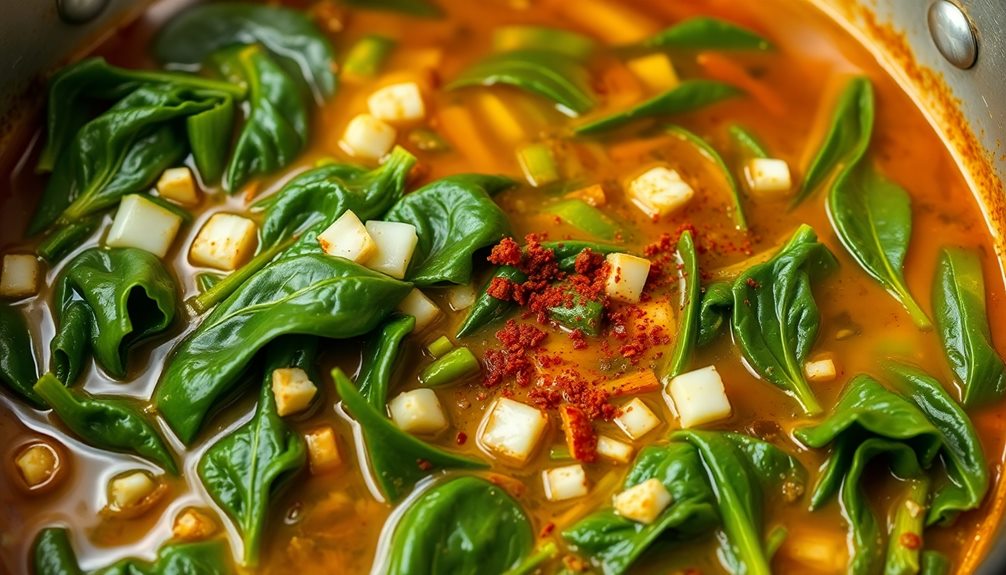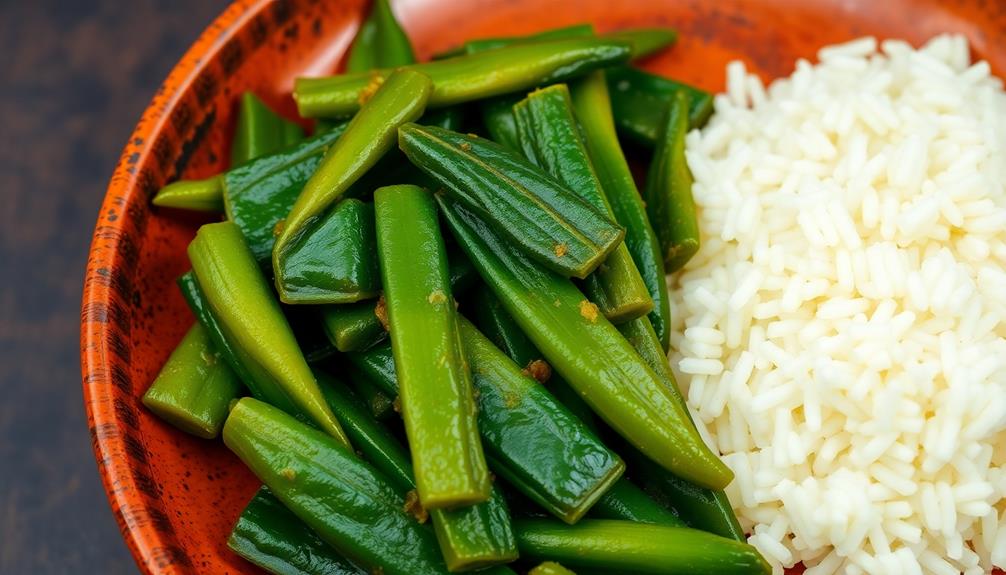Collard greens come to us from the rich culinary traditions of Africa, where they've been enjoyed for centuries. These nutrient-dense leaves offer a robust, earthy flavor that pairs beautifully with a variety of seasonings. To prepare them, you'll want to give the greens a thorough wash, chop them into bite-sized pieces, and sauté them with aromatic ingredients like onion, garlic, and spices. Simmering the greens enhances their tenderness and allows the flavors to meld together. Serve the collard greens with cooked grains or legumes for a wholesome, balanced meal. These greens are not only delicious, but they also contribute an array of essential vitamins, minerals, and fiber to your diet. Intrigued? Let's dive deeper into the fascinating history and preparation of this beloved African dish.
Key Takeaways
- Collard greens originated in Africa, where they have been cultivated for centuries and remain a staple in many regional cuisines.
- The robust flavor and high nutritional value of collard greens have contributed to their global popularity and cultural significance.
- Collard greens can be prepared by washing, chopping, sautéing with aromatics, and simmering to achieve tenderness and enhanced flavor.
- Pairing collard greens with cooked grains or legumes creates a balanced and nutritious meal that showcases the dish's versatility.
- Incorporating collard greens into one's diet can provide a wealth of essential vitamins, minerals, and fiber, making it a nutrient-dense and healthy choice.
History
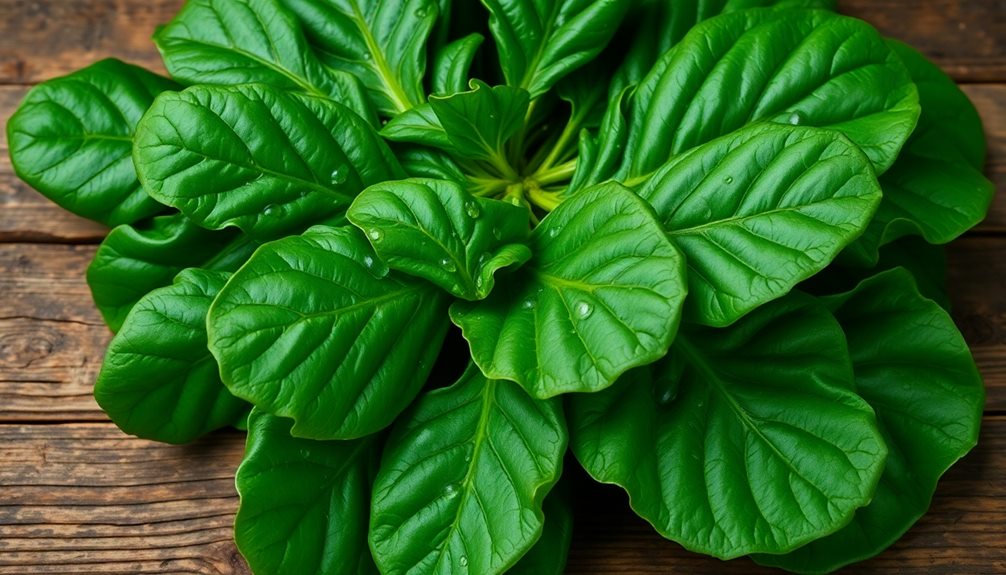
The origins of African collard greens can be traced back to the African continent, where they've been cultivated for centuries. These nutrient-dense leafy greens have been a staple in the diets of many African communities, with each region developing its own unique recipes and preparation methods.
Over time, the cultivation of African collard greens spread to other parts of the world, including the Americas, where they became a beloved ingredient in traditional Southern cuisine.
Today, these versatile greens are enjoyed by people of all backgrounds, who appreciate their robust flavor and impressive health benefits.
Whether you're a seasoned cook or just starting to explore the world of African cuisine, collard greens are a must-try ingredient. Their history is as rich and vibrant as their deep green hue, and they offer a delicious way to add more nutrition to your meals.
Cooking Steps
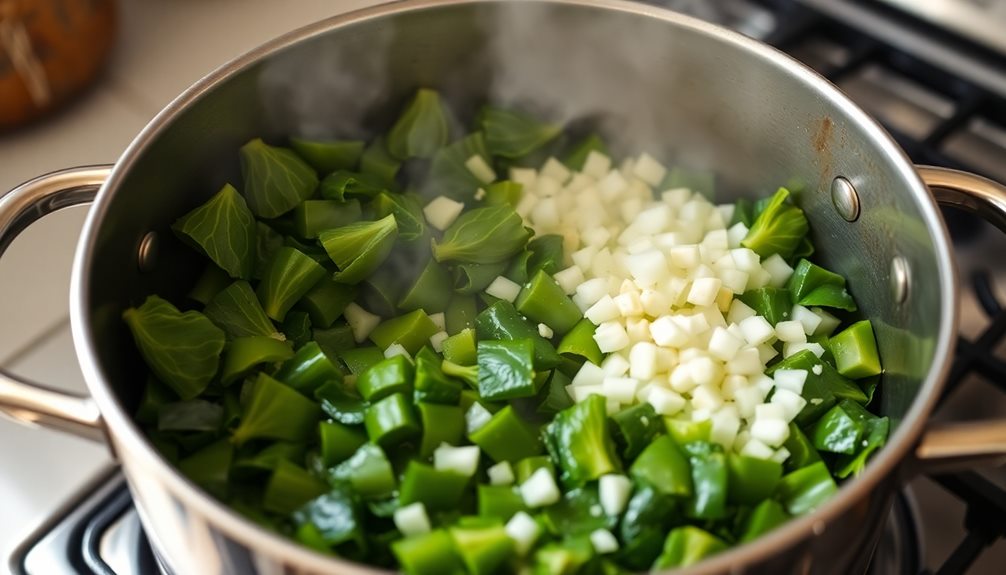
To begin, gather the necessary ingredients and equipment. You'll need a large pot, a sharp knife, a cutting board, and the star of the show – fresh, vibrant collard greens.
Wash the greens thoroughly, removing any dirt or debris. Then, grab your knife and slice the leaves into bite-sized pieces, discarding the tough stems.
Next, add a drizzle of oil to the pot and heat it over medium-high. Once the oil is shimmering, add in the chopped collard greens.
Sauté the greens, stirring occasionally, until they start to wilt and become tender, about 5-7 minutes. Now, it's time to season them to perfection! Sprinkle in a pinch of salt, a dash of pepper, and a splash of broth or water.
Let the greens simmer for an additional 10-15 minutes, allowing the flavors to meld together.
Taste the collard greens and adjust the seasoning as needed. Once they're cooked to your liking, remove the pot from the heat and serve piping hot.
Enjoy the bold, earthy flavors of this African-inspired dish!
Step 1. Wash Collard Greens Thoroughly
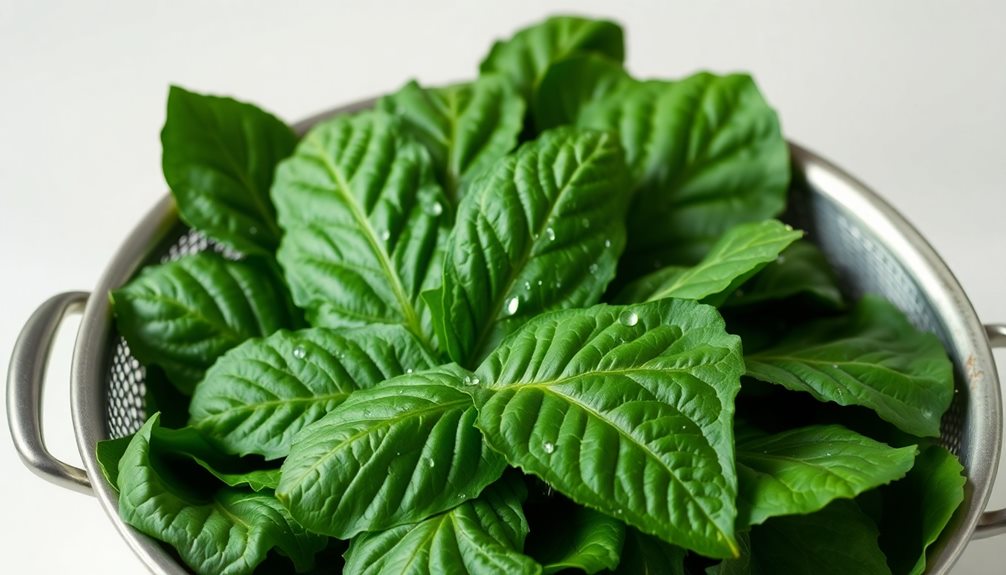
Thoroughly rinsing your collard greens is crucial to remove any dirt, grit, or debris that may have accumulated on the leaves.
Start by filling a large bowl or your clean kitchen sink with cold water. Gently submerge the collard greens, one bunch at a time, and swish them around to dislodge any stubborn particles. Be sure to check the undersides of the leaves, as that's where dirt tends to hide.
Once the water becomes murky, drain the greens and repeat the process until the water runs clear. This extra step ensures your collard greens are clean and ready for the next phase of cooking.
Don't forget to pat the leaves dry with a clean kitchen towel or paper towels. Removing excess moisture will help the greens cook more efficiently.
With your collard greens washed and dried, you're one step closer to enjoying this nutrient-packed, flavorful African dish. Get ready to savor the bold, earthy taste!
Step 2. Chop Collard Greens Into Bite-Sized Pieces
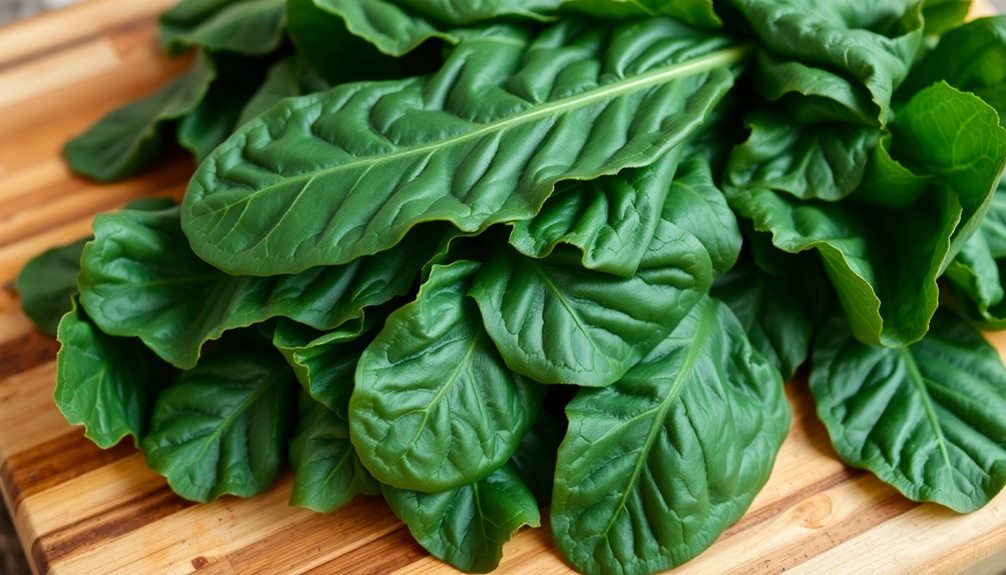
After thoroughly rinsing the collard greens, grab a sharp knife and start chopping the leaves into bite-sized pieces. This will make the collards easier to chew and digest.
Take your time and slice the leaves crosswise into strips that are about 1 inch wide. As you work, gather the leaves into small bunches to keep them organized.
When you reach the tough stems, simply slice them off and discard them. The goal is to have a bowl full of bright green, evenly chopped collard greens that are ready to cook.
This step ensures the collards will soften up nicely and absorb all the delicious flavors you'll be adding later. Once you've chopped everything, give the collards one more gentle rinse to remove any lingering dirt or debris.
Now you're all set to move on to the next part of this authentic African recipe!
Step 3. Sauté Aromatics in Oil
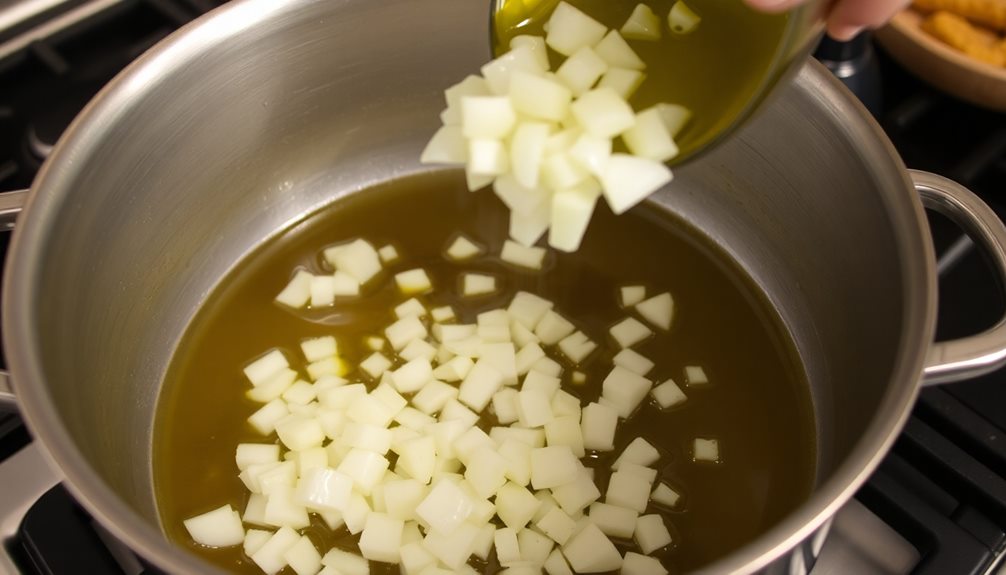
Next, heat a large skillet or Dutch oven over medium-high heat. Add a few tablespoons of the aromatic oil you prepared earlier.
Once the oil shimmers, toss in the chopped onion, garlic, and ginger. Sauté these veggies, stirring frequently, until they're soft and fragrant – about 3 to 5 minutes.
This aromatic base is crucial for enhancing the overall flavor of the dish, similar to how herb-infused cocktails elevate classic drinks with fresh notes of flavor and aroma.
Now, it's time to add the spices! Sprinkle in the cumin, coriander, and smoked paprika. Give everything a good stir and let the spices toast for a minute or two, until their aroma fills the air.
This step helps to intensify the flavors, much like how fermentation enhances the nutritional value and flavor profiles in dishes like a fermented vegetable plate.
Once the aromatics are sizzling and the spices are fragrant, it's time to add the chopped collard greens. Toss the greens in the skillet, coating them evenly with the oil and spices.
Sauté for 5 to 7 minutes, until the leaves start to wilt and become tender. Remember to stir occasionally to prevent burning.
Step 4. Add Simmered Greens
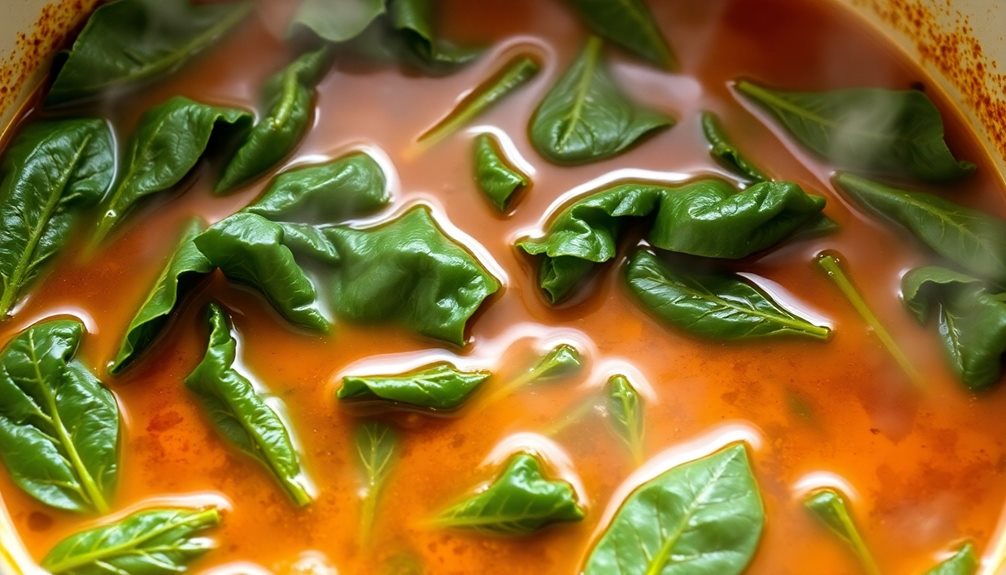
Once the collard greens have been sautéed, add the vegetable stock and bring the mixture to a simmer. This gentle simmering helps to tenderize the collard greens and infuse them with delicious flavors.
Let the greens simmer for about 15-20 minutes, stirring occasionally, until they're tender and the liquid has reduced slightly. You'll know they're ready when you can easily pierce them with a fork.
During the simmering process, be sure to season the greens with salt and pepper to taste. This will help to bring out their natural sweetness and balance the flavors.
You can also add a pinch of crushed red pepper flakes if you want to add a little heat. As the greens cook, the flavors will meld together, creating a comforting and nourishing dish that's perfect to serve alongside your favorite entree or on its own as a satisfying meal.
Step 5. Serve With Cooked Grains or Legumes
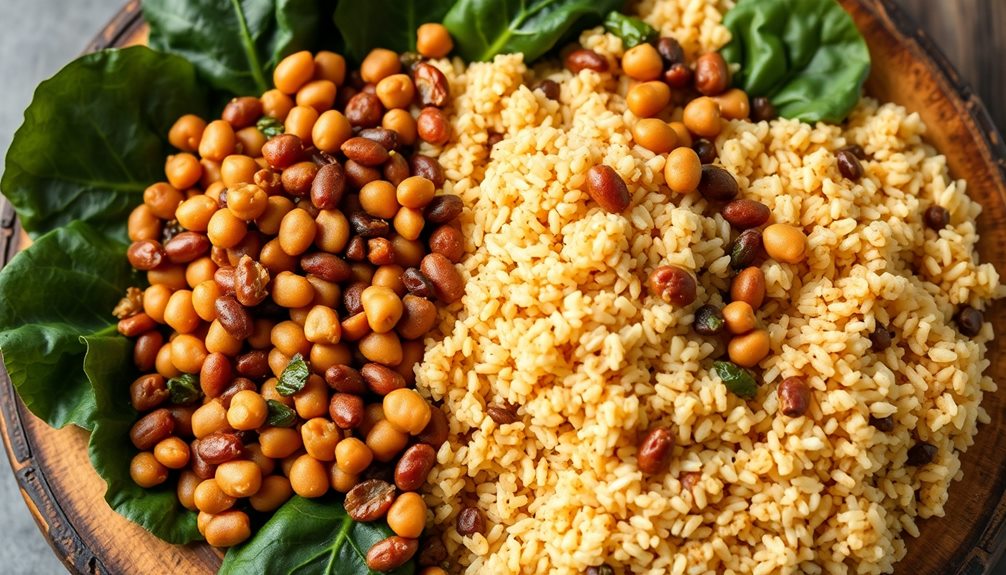
To make the collard greens even more filling and nutritious, you can serve them alongside cooked grains or legumes. Hearty quinoa or brown rice would be a delicious pairing, providing complex carbohydrates and a boost of protein.
Additionally, incorporating these cooked grains can enhance the meal's overall fiber content, promoting better digestion and satiety, as seen with whole foods like juices versus whole fruits. Or, try serving the collard greens with a side of tender, simmered lentils or chickpeas – they'll add even more fiber and nutrients to the dish.
The possibilities are endless! You could even mix things up by serving the collard greens over a bed of fluffy couscous or nutty farro.
The key is to choose a grain or legume that complements the bold flavors of the greens. Together, they'll create a satisfying and well-balanced meal that will keep you feeling energized and satisfied.
Whichever option you choose, the collard greens and cooked grains or legumes will make for a nutritious and flavorful combination that's sure to please your palate.
Final Thoughts
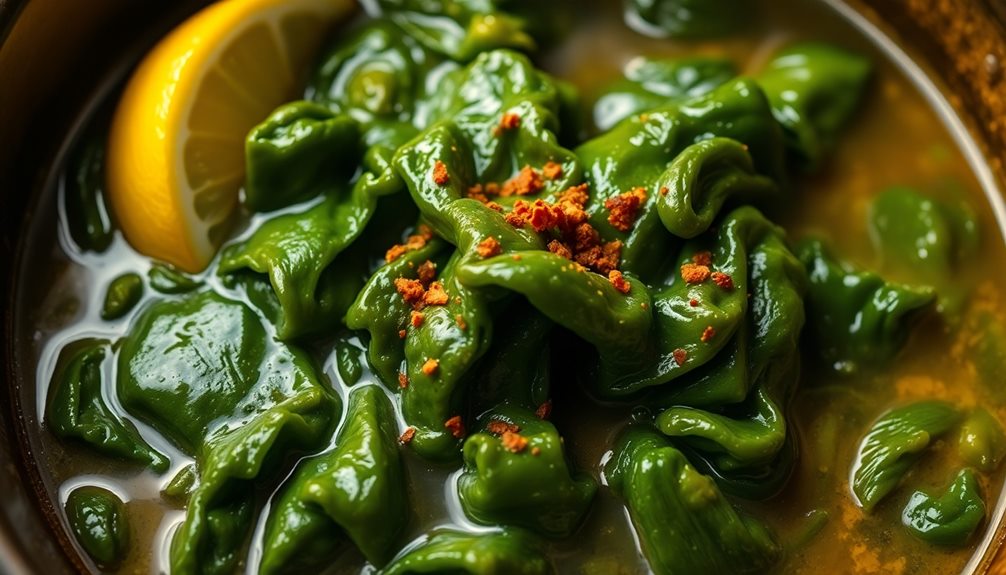
African collard greens are a versatile and nutrient-dense vegetable that deserve a place in any healthy diet. With their robust flavor and impressive nutritional profile, these greens can be enjoyed in a variety of ways.
Whether you serve them alongside cooked grains or legumes, or simply as a side dish, collard greens are a delicious and healthy addition to any meal.
As you've learned, collard greens are packed with essential vitamins, minerals, and fiber, making them a powerhouse of nutrition.
Plus, their earthy, slightly bitter taste pairs beautifully with a range of seasonings and cooking methods. Plus, their earthy, slightly bitter taste pairs beautifully with a range of seasonings and cooking methods. From roasting with a drizzle of olive oil to tossing into hearty stews, they can elevate any dish with their rich, nuanced flavor. For those exploring Asian cuisine, understanding pork sung and pork fu differences can open up even more possibilities for creative pairings and toppings, adding depth and texture to complement these distinctive flavors.
Frequently Asked Questions
What Are the Health Benefits of African Collard Greens?
African collard greens are packed with vitamins A, C, and K, and provide fiber, folate, and antioxidants. They can help support a healthy immune system, promote cardiovascular health, and aid in digestion.
How Can I Add More Flavor to My African Collard Greens?
To add more flavor to your African collard greens, try sautéing them with aromatic ingredients like garlic, onions, and smoked paprika. You can also braise them in a flavorful broth or season them with a dash of apple cider vinegar.
Are African Collard Greens Suitable for Vegetarian or Vegan Diets?
Yes, African collard greens are suitable for vegetarian or vegan diets. They're packed with nutrients and can be cooked without any meat or dairy products, making them a great option for plant-based eaters.
How Do African Collard Greens Differ From Traditional Collard Greens?
African collard greens differ from traditional collard greens in their more robust, earthy flavor and longer cooking time. They're often seasoned with smoked or salted meats, whereas traditional collards may be prepared with plant-based seasonings.
Can I Use Frozen African Collard Greens in Recipes?
Yes, you can use frozen African collard greens in recipes. They retain their nutrients and flavor, so you can enjoy the same great taste and health benefits as fresh collard greens.
